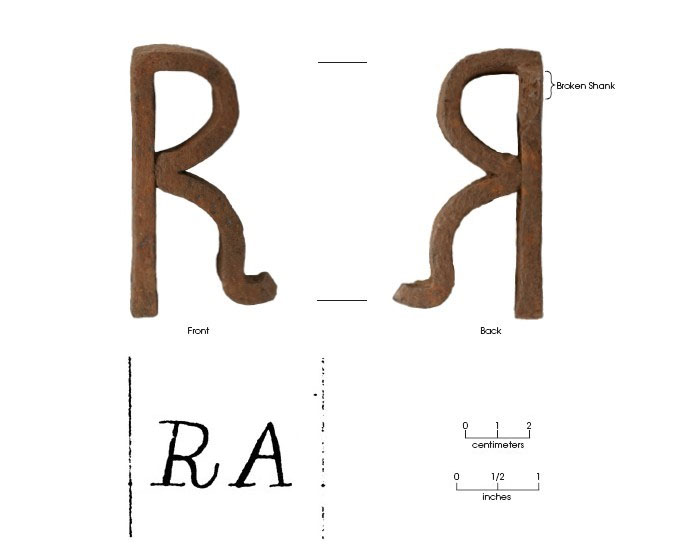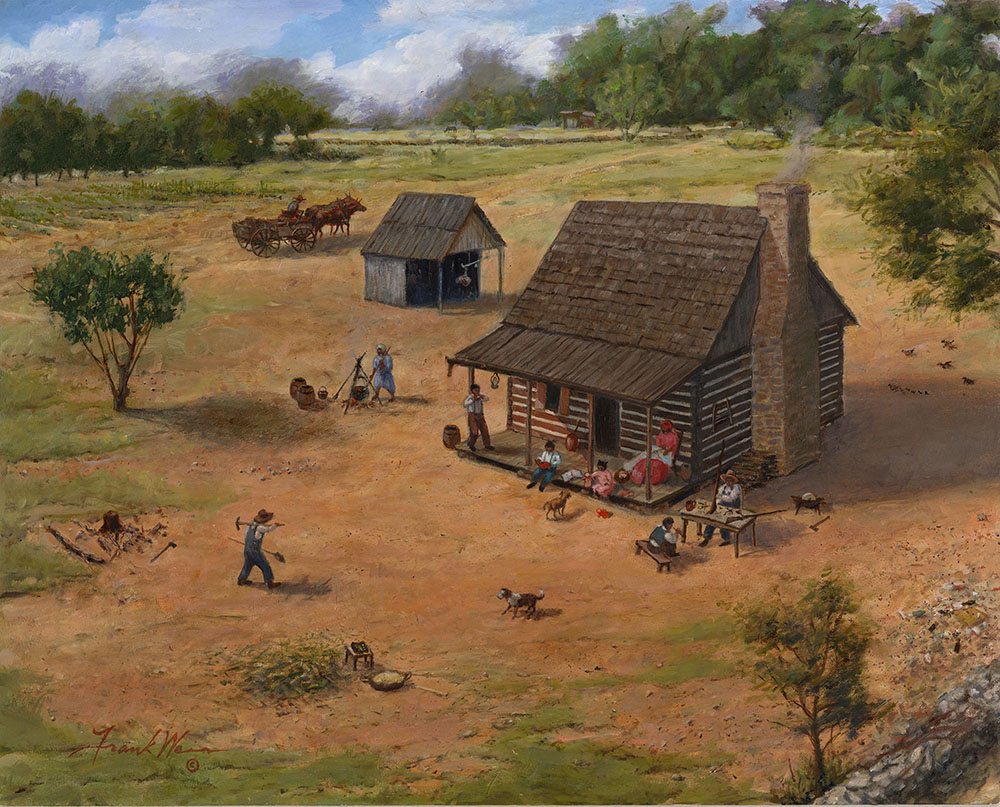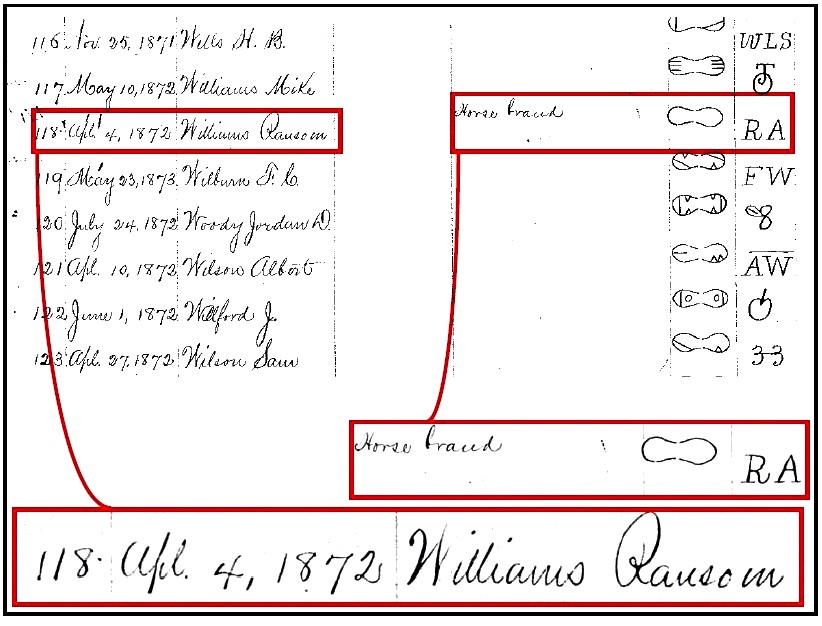
Object: Horse Branding Iron fragment
Date: ca. 1872
Context: Bear Creek, Hays and Travis Counties, Texas, Ransom and Sarah Williams Farmstead
The Travis County Register of Marks and Brands indicates that a horse brand was registered on April 4, 1872 by Ransom Williams, an emancipated African American slave. Aside from county records such as this one, Ransom Williams makes few appearances in the historical records, not even the US census, in his 55 or more years of life. Despite scant historical documentation, tangible evidence of the lives of Ransom Williams, his wife Sarah, and their children was preserved at his farmstead south of Austin, including this hand-forged letter "R"—a fragment of a branding iron matching the image shown in the county register. Today, cars zip over the Williams farmstead on toll road State Highway 45 SW between Buda and Austin. This brand and the story of Ransom Williams might have been obliterated during highway construction, but instead the story has found new life in the hearts of scholars and Central Texas community members. Ransom's brand is emblematic of his hard work as a farmer and horseman, his status as a citizen of the United States and as a landowner, and his individual identity—in essence, Ransom's story echoes the American Dream.

African American slaves in Texas were emancipated in 1865 at the beginning of Reconstruction, the period following the Civil War when the federal government attempted to bring southern states back into the fold of the Union and enforce the rights of the newly freed slaves. Despite government efforts, many rural southern blacks continued to live marginalized lives of servitude, especially in the Jim Crow era immediately following Reconstruction. Ransom Williams and his family were among the minority living in relative prosperity. Ransom's 40 acres of rocky upland property was not ideal farmland, and farm life is hard no matter how you split it, but tax records show that Ransom owned as many as 6 to 9 horses or mules at one time during the 1870s—a whoppingly high number compared to his white neighbours and other black freedmen at the time. Archeologists and historians are uncertain how Williams was able to afford his land and livestock, but they speculate that he had acquired marketable skills working with horses in his early life.

As seen in the Register of Marks and Brands pictured here, the "R" was followed by the letter "A". Of course, "RA" is an abbreviation of Ransom. Strangely, the "R" found during excavations was affixed to the handle backwards; an iron shank was once attached to the brand on the reverse side, resulting in a mirrored "R" once this brand was seared into a horse's side. Archeologists infer that it was a mistake on the part of the blacksmith, which upon realization was removed from the iron but kept by Ransom.
The Ransom Williams farmstead was excavated between 2007-2009 by the consulting firm Prewitt and Associates, Inc. on behalf of the Texas Department of Transportation in advance of construction of State Highway 45. The brand was one of over 26,000 artifacts recovered during this project. It was found near the northwest corner of the log cabin, and it may have been hung on the outside wall under the eaves of the roof. The find helped confirm that the home site was indeed that of Ransom Williams.
The extensive TBH exhibit, Ransom and Sarah Williams Farmstead discussed the site and its excavation, archival research, and oral histories with Ransom's descendants now living in East Austin and descendants of Ransom's contemporaries at the Antioch Colony in Manchaca (a historic settlement of freed slaves), located a few miles from his property, and descendants of his Anglo-American neighbours. The TBH exhibit includes a video clip of project historian Terri Myers discussing how she found Ransom Williams in the registry of brands and how her finding linked to the actual brand discovered at the site.
Credits
Adapted from Boyd et al. (2015) and the Williams Farm TBH exhibit by TBH Editorial Assistant Emily McCuistion, with help from Doug Boyd. Doug now works for Cox McLain Environmental Consulting.
Print Sources
Boyd, Douglas K.
2012 Archeological Awareness: Research Site is One of Texas' Best-Preserved African American Farmsteads. The Medallion 50(4):3-4. Fall 2012. Available online at: https://www.thc.texas.gov/public/upload/publications/medallion-fall-2012_0.pdf
Boyd, Douglas K., Maria Franklin, and Terri Meyers
2011 From Slave to Landowner: Historic Archeology at the Ransom and Sarah Williams Farmstead. Current Archeology in Texas 13(1):8-15. Available online at:
https://www.thc.texas.gov/public/upload/publications/current-archeology-april-2011.pdf
Boyd, Douglas K., Aaron R. Norment, Terri Myers, Maria Franklin, Nedra Lee, Leslie L. Bush, and Brian S. Shaffer
2015 The Ransom and Sarah Williams Farmstead: Post-Emancipation Transitions of an African American Family in Central Texas. Two Volumes. Reports of Investigations No. 173, Prewitt and Associates, Inc., Austin, Texas, and Archeological Studies Program Report No. 139, Texas Department of Transportation, Austin, Texas.
Franklin, Maria
2012 "I'm Proud To Know What I Know": Oral Narratives of Travis and Hays Counties, Texas, ca. 1920s-1960s. Two Volumes. Reports of Investigations No. 165, Prewitt and Associates, Inc., Austin, Texas, and Archeological Studies Program Report No. 136, Texas Department of Transportation, Austin, Texas.
Online Source
KLRU Television
2010 Once Upon a Time Ransom Williams Crossed Highway 45 Southwest. KLRU public television program aired June 17, 2010, in central Texas. The hour-long program features 28 minutes on the archeology of African American life at the Williams Farmstead, Travis County, Texas. Entire program is available online at the KLRU website: http://www.klru.org/juneteenth/episode/2010/